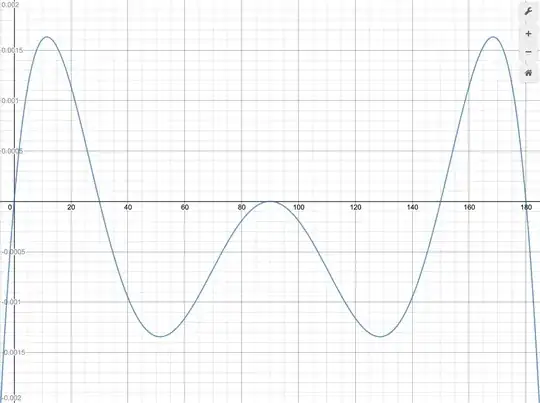Tailored Taylor
You can use Taylor but first you need to pack your angle into the region $x_1=0,2\pi$. simply by $x \mod 2\pi$
Once you are there if $x_1>\pi$ take the result as $\sin(x_1)=-\sin(x_1 - \pi)$ reducing it to $x_2=0,\pi.$
Now if $x_2>\frac{\pi}{2}$ calculate the result as $\sin(x_2)=\sin(\pi-x_2)$.
So all this above is easily shifting it all to $x_3=0,\frac{\pi}{2}$
If needed use further
$$ \sin(x)=2\sin(\frac{x}{2})\cos(\frac{x}{2})$$
with
$$ \cos(\frac{x}{2})=\sqrt{1-\sin(\frac{x}{2})^2}$$
in case $x_3>1.$
All this is making the Taylor expansion much more accurate within a lesser number of steps as $x^n$ in it for $x<1$ will rapidly go to $0$ besides the help from factorial.
Next you represent Taylor series of $\sin(x)$ in a much more handy way
$$\sin(x)=x(1-\frac{x^2}{3 \cdot 2}(1-\frac{x^2}{5 \cdot 4}(1-\frac{x^2}{7 \cdot 6}(…$$
Notice that $x^2$ is repeating. So choose $k$ as big as you are willing to calculate and have
$$f(0)=1-\frac{x^2}{(2k+1) \cdot 2k}$$
$$f(n)=1-\frac{x^2}{(2(k-n)+1) \cdot 2(k-n)}f(n-1)$$
Finally
$$\sin(x)=xf(k-1)$$
Binary ladders
For this method as well you need to bring the angle as much down as you can as explained above.
If you do not want to deal with division, otherwise you can use $\tan(x)$, the task is possible with multiplication only. Take the small $m$ and
$$ \sin(m)\approx m = x_0$$
$$\cos(m) \approx 1-\frac{m^2}{2} = y_0$$
Then have:
$$M_{2^0} = \begin{bmatrix}y_0 & x_0 \\-x_0 & y_0 \end{bmatrix}$$
$$M_{2^{k+1}} = (M_{2^{k}})^{2}$$
this is just based on duplication formula for $\sin(x)$ and $\cos(x)$
Now it is up to you what small $m$ you will use as a reference. It can be for example $\frac{1}{2^{10}}$ or $0.00001$ or any other small number. Smaller it is, a better precision you have.
Now you find the integer $n$ so that $nm \leq x < (n+1)m$
The game can start.
Write $n$ in binary expansion.
$$\sum_{d=1}^{m}{2^{k_d} } = n$$
Using
$$\sin(x+y)=\sin(x)\cos(y)+\cos(x)\sin(y) $$
$$\cos(x+y)=\cos(x)\cos(y)-\sin(x)\sin(y)$$
which is in our case
$$\begin{bmatrix}y_p & x_p \\-x_p & y_p \end{bmatrix} \displaystyle \begin{bmatrix}y_q & x_q \\-x_q & y_q \end{bmatrix}$$
since we are dealing with evaluation of $\sin(x), \cos(x)$ all the time you additionally multiply
$$M_{2^{k_1}}M_{2^{k_2}} … M_{2^{k_m}}$$
where
$$\sum_{d=1}^{m}{2^{k_d} } = n$$

